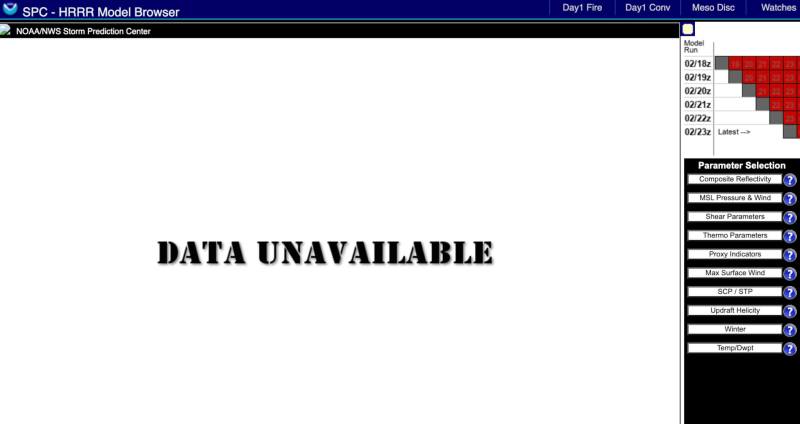In the realm of weather forecasting, particularly when it comes to the volatile world of tornadoes, the HRRR (High-Resolution Rapid Refresh) radar model stands as a formidable tool. This advanced piece of technology offers meteorologists and storm chasers an unprecedented level of detail, allowing them to delve into the heart of severe storms and pinpoint areas most conducive to tornado formation.

The HRRR’s strength lies in its ability to simulate rapidly changing conditions within thunderstorms with exceptional resolution, refreshing its data as frequently as every 15 minutes. This means that forecasters can track the evolution of storm structures, monitor shifts in wind patterns, and analyze parameters like CAPE (Convective Available Potential Energy) – the fuel for explosive storms. Alongside this, the HRRR provides insights into helicity values, crucial indicators of rotation within a storm, giving us hints as to where tornadoes could spin up.

Meteorologists at the National Weather Service (NWS) rely heavily on the HRRR to issue timely warnings, especially considering the short lead times tornadoes often have. Storm chasers, driven by a mix of scientific curiosity and adrenaline, also utilize HRRR data. They dissect the model’s output, looking for telltale signs of severe weather, which helps them position themselves effectively to document and even potentially intercept tornadoes.
- Severe Weather Outlooks: The Storm Prediction Center (SPC) often mentions the HRRR in its forecast discussions for severe weather events. You can look up archived outlooks and see where the HRRR highlighted potential hot-spots.
- Post-Storm Analysis: Sometimes, research papers or blog posts analyze a tornado outbreak after the fact. These might discuss how the HRRR successfully predicted areas favorable for the formation of severe storms.
- Storm Chaser Community: Storm chasers are often very plugged into HRRR data. Their videos and social media posts may document how they relied on the HRRR to position themselves for intercepts.
In recent years, the advancement of numerical weather prediction models like the HRRR has played a key role in improving tornado forecasts. While no single technology guarantees perfect prediction, the HRRR’s high-resolution simulations, coupled with the expertise of meteorologists and storm chasers, have undoubtedly led to better identification of potential tornado hotspots. This translates into more timely warnings, giving the public crucial extra minutes to seek shelter and minimize the devastating impacts of these violent storms.

“The HRRR’s advanced capabilities are incredibly useful, but it’s important to remember that all weather radars, including the data powering the HRRR, stem from Doppler radar technology. This technology allows meteorologists to “see” precipitation within storms and analyze its characteristics.”
While the HRRR marks a milestone in severe weather prediction, the quest for even more accurate and timely tornado forecasts continues. Researchers are exploring ways to assimilate more data sources into the model, along with cutting-edge radar technologies like phased array radars, which offer ultra-fast scans. As technology progresses, the combination of advanced tools with expert human analysis will be the key to further unlocking the secrets of tornadoes and, ultimately, saving lives.
The Future of Tornado Detection
While current tools have enhanced our ability to predict severe storms, the future holds even greater promise. Phased array radar offers lightning-fast updates on evolving storm structures, a huge leap over traditional radar. Alongside this, advanced weather models fueled by AI are rapidly improving. These models can analyze massive amounts of data to identify subtle patterns that might lead to tornadoes, significantly aiding in short-term forecasting.
Taking it to the Skies
An exciting emerging technology involves drone swarms. These networks of sensor-equipped drones could gather unprecedented close-up data on storm features. This information would be invaluable for researchers trying to unravel the mysteries of tornado formation.
The Power of Integration
True advancement lies in combining these tools. Imagine sensor data from phased array radar, drones, and satellites all integrated into AI-powered models. This would provide a complete picture of the storm, enabling meteorologists to predict tornadoes with higher accuracy and longer lead times. Making this technology and its analysis readily accessible will revolutionize warnings and public safety decision-making.
Bottom Line
The HRRR radar model provides meteorologists and storm enthusiasts with a powerful lens into the heart of rapidly evolving thunderstorms. Its high resolution, frequent updates, and specialized parameters offer crucial insights into the potential development of tornadoes. While no single technology guarantees perfect prediction, the HRRR stands as a testament to ongoing innovation in weather forecasting. As the HRRR continues to evolve alongside other cutting-edge tools, the future holds the promise of even more precise and timely tornado warnings – a crucial step towards minimizing the devastating impact of these unpredictable storms.
